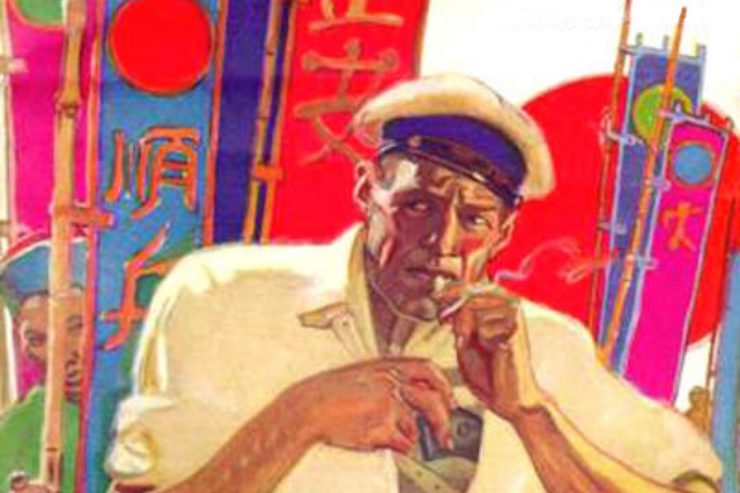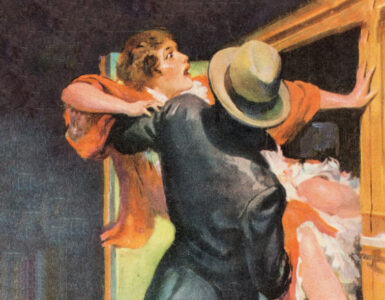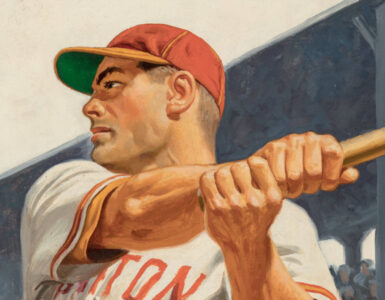Pulp magazines have influenced writers, artists, film directors, software developers, and countless others over the years. Our “PulpFest History” articles focus on the rough-paper writers, editors, publishers, and artists who have inspired and continue to inspire the creators of the world’s popular culture.
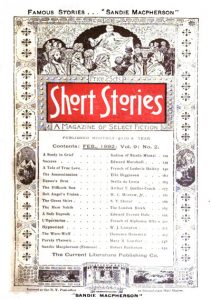 Dorothy McIlwraith is not a name that comes readily to mind when looking into pulp magazine history. Born 130 years ago on October 14, 1891, and raised in Hamilton, Ontario, Dorothy attended McGill University in Montreal, obtaining a degree in English. She would soon follow the career path of her aunt, Jean McIlwraith, who had been employed by Doubleday in New York before deciding to devote more time to her own writing.
Dorothy McIlwraith is not a name that comes readily to mind when looking into pulp magazine history. Born 130 years ago on October 14, 1891, and raised in Hamilton, Ontario, Dorothy attended McGill University in Montreal, obtaining a degree in English. She would soon follow the career path of her aunt, Jean McIlwraith, who had been employed by Doubleday in New York before deciding to devote more time to her own writing.
Recognizing her talents, Doubleday’s Harry Maule brought Dorothy into the editorial department of SHORT STORIES. In late 1936, she would succeed Maule as editor of the magazine. In 1940, McIlwraith would likewise follow Farnsworth Wright as editor of WEIRD TALES.
With SHORT STORIES, McIlwraith inherited a popular and financially successful publication. She maintained her editor role of the magazine until choosing to retire. With WEIRD TALES, the pulp was frequently in a state of financial flux. Dorothy was still able to bring in notable new authors and artists, guiding “The Unique Magazine” until its demise in 1954. Her editing skills were noted favorably by many a pulp fiction author as well as by pulp historians.
What makes Dorothy McIlwraith’s lengthy career editing two significant pulp fiction magazines even more noteworthy is that she was a female editor, one of a very few in a male-dominated industry. She was, truly, one of the great editors of the pulp era.
Dorothy McIlwraith, Editor, SHORT STORIES and WEIRD TALES
(from the November 1942 issue of WRITERS’ JOURNAL)
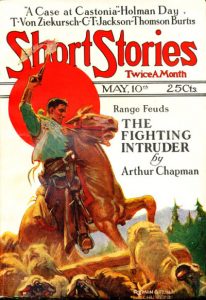 SHORT STORIES is strictly a man’s magazine and is read by men of action all over the world. It is to be found in such strictly men’s places as Army camps and onboard merchant ships, and it is a favorite in the Navy.
SHORT STORIES is strictly a man’s magazine and is read by men of action all over the world. It is to be found in such strictly men’s places as Army camps and onboard merchant ships, and it is a favorite in the Navy.
WEIRD TALES is pretty much of a man’s magazine, too. But the editor of the two publications is no Ernest Hemingway or Jim Tully. The editor is Dorothy McIlwraith, a pleasant, quiet, and soft-spoken woman, who received curious training for her job: she majored in Anglo-Saxon at McGill University.
Because the editorship of SHORT STORIES would supposedly be a he-man’s job, Miss McIlwraith did not come directly to the task. She acquired it so gradually that the significance of being a woman in a man’s job is almost wholly lost on her by now. Nor do others except perhaps new writers wonder about it, either. For she has made good at the task in no uncertain manner, as will readily be testified from innumerable sources.
There is a great deal of distinction to SHORT STORIES. It is not only the oldest pulp, having been started in 1890, but readers continue to pay 25¢ a copy for it, at a time when most pulps sell for 10 or 15¢. It has published many notable names and still continues to do so.
On the shelves in Miss McIlwraith’s office in Radio City, New York, at 9 Rockefeller Plaza, are copies of the little old magazines that were the first numbers of the SHORT STORIES that began publication in 1890.
“It is intended to entertain and not particularly to instruct,” said an announcement in the first number. “While the lowest reading intelligence can raise to an understanding of its material, the highest will not find it uninteresting, commonplace or beneath appreciation.”
During all that time, SHORT STORIES has kept to its main purpose — to entertain. Miss McIlwraith, like her predecessors in the editor’s chair, has seen to that.
As the magazine grew, literary giants indeed were represented in its pages. Thumbing pages of the early issues, Miss McIlwraith discloses such names as Kipling, Conan Doyle, O. Henry, Gilbert Parker, Bret Harte, Mark Twain, W. W. Jacobs, Laura E. Richards, Gertrude Atherton, and Ambrose Bierce, to list but a few as contributors.
Early stories by such divergent modern celebrities as Ray Stannard Baker and Ellen Glasgow were written especially for the magazine.
“The Cook’s Victory,” by a youngster of 19 who bore the name of H. L. Mencken, appeared in SHORT STORIES in 1900. In a recent letter, Mencken explained that the story was a byproduct of his early reporting days on the Baltimore MORNING HERALD when he covered a raid on an employment agency which specialized in shanghaiing men for the Chesapeake Bay oyster fleet.
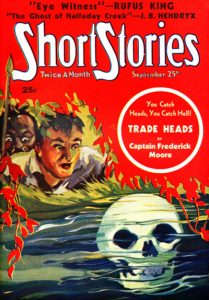 The magazine somewhat in its present form began to emerge under the editorship of Harry Peyton Steger. By Steger’s time, SHORT STORIES had been taken over by Doubleday, Page & Company, and when Steger died in 1912, Harry Maule became its editor and continued to guide the policies of the publication for many years.
The magazine somewhat in its present form began to emerge under the editorship of Harry Peyton Steger. By Steger’s time, SHORT STORIES had been taken over by Doubleday, Page & Company, and when Steger died in 1912, Harry Maule became its editor and continued to guide the policies of the publication for many years.
It is an interesting fact that for a time Margaret Porter, O. Henry’s daughter, was its assistant editor, and in each issue, there was an O. Henry story.
Magazines were not so specialized at that time as they later became, and there were probably a tenth as many of them published as there are today. The general fiction magazine was lessening in appeal and magazines for more highly selective publics were taking its place. With its excellent author background, a very definite editorial policy of red-blooded fiction was growing in SHORT STORIES. Its appeal was to readers who wanted adventure and action and the thrill of far places; whose interest was in real characters functioning in situations and emergencies calling for resource and gallantry; who glorified in the exploits of the pioneers in our own West and on the frontiers of the world. That still goes now.
“We are using plenty of present-day adventure stories,” says Miss McIlwraith, “but we want stories of people in the war rather than out and out war stories. We use settings all over the world, and lots of people know of out-of-the-way corners now in the news from fiction in our pages over a period of many years.”
Miss McIlwraith was associate editor of SHORT STORIES when it was owned by Doubleday, Doran, the former Doubleday, Page, and came with the publication when it was bought by W.J. Delaney, an advertising man, in 1937.
She was born in Hamilton, Canada. Her first job in New York was with AMERICAN magazine. She was with the old INDEPENDENT for about a year and worked with the Rockefeller Foundation for a very short period before joining Doubleday, Doran as a book manuscript reader. Subsequently, she found herself in the editorial department of SHORT STORIES.
The magazine buys short stories up to 6,000 words, novelettes of approximately 10,000 words, complete novels, and serials. It buys most of its material from names, but unknowns have a good chance of landing in its pages if they have the stuff, and good rates are paid, on acceptance.
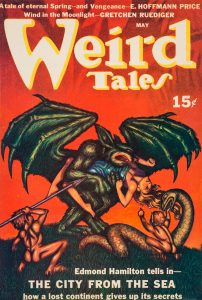 WEIRD TALES, which Miss McIlwraith has been editing for the past three years, buys fiction of between 4000 and 12,000 words of the fantasy, supernatural, pseudo-science, and horror type.
WEIRD TALES, which Miss McIlwraith has been editing for the past three years, buys fiction of between 4000 and 12,000 words of the fantasy, supernatural, pseudo-science, and horror type.
Miss McIlwraith welcomes contributions for SHORT STORIES and declares “it is really quite a thrill to find a first-rate story from a person we have never heard of before.
“But we become immediately suspicious,” she adds. “We have to. Only too often do magazines get caught cold with stories written by famous authors which have been copied by aspiring amateurs.
“No one person can know the whole action literature field and so we have devised a few safeguards to try and project ourselves from the classic blunder one editor made. He bought a Robert Louis Stevenson story and published it under the name of a high school youngster.
“So — paradox though it is — we are always suspicious when a well-written manuscript comes in from an unknown. First, we make inquiries among agents and editors to see if any of them know his work. If this avails nothing we ask the author for literary references. In cases of a ‘first story’ he can’t, of course, give any. So we then ask for references from an acquaintance, a school principal, banker, or someone like that.
“If a person who has written a good story can pass this examination we are naturally excited. We have discovered a new writer. Still, there are lurking fears. Possibly the first story was a fluke. There are, you know, ‘one-story’ writers — people who are through once they have told the one story that has been fermenting in them for years. But if they go ahead with a second and a third story that clicks, all fears depart.”
The chief reason for rejections from SHORT STORIES is that most of the material submitted does not meet technical requirements, Miss McIlwraith says.
“On average, we will receive about 200 manuscripts a week. At least half of these are completely out of our field — stories of young love and that kind of thing. Half of the remainder can be discarded at first glance, being ungrammatical, written in painful pencil scrawls, or something of that kind. The balance gets a careful reading.”
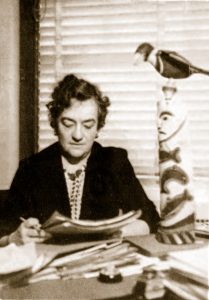 Out of those careful readings come the stories that are published in SHORT STORIES, and Miss McIlwraith gets no little aid in making her selections from the “SHORT STORIES’ Totem Pole,” a conspicuous object in her office. The totem pole, pictured with Miss McIlwraith on this page, comes from British Columbia, and, Miss McIlwraith stoutly asserts that it, “has sound editorial judgment.”
Out of those careful readings come the stories that are published in SHORT STORIES, and Miss McIlwraith gets no little aid in making her selections from the “SHORT STORIES’ Totem Pole,” a conspicuous object in her office. The totem pole, pictured with Miss McIlwraith on this page, comes from British Columbia, and, Miss McIlwraith stoutly asserts that it, “has sound editorial judgment.”
When not at her offices in Radio City, Miss McIlwraith lives in one of those restored old houses that make people into enthusiastic country dwellers. She has a great curiosity about all sorts of activities and (tip!) likes out-of-doors sort of authors very much.
To learn more about Dorothy McIlwraith and her career in publishing, pick up a copy of THE PULPSTER #30 and read Tony’s groundbreaking article on the editor of SHORT STORIES and WEIRD TALES. You can order a copy by clicking here.
Debuting with its June 1890 issue, SHORT STORIES was initially a literary magazine that largely reprinted stories from around the world. The February 1892 number of the magazine was a typical issue during the magazine’s first three years. It began to use a small black and white illustration on the cover with its December 1892 issue.
Although labeled the “oldest pulp” in our WRITERS’ JOURNAL reprint, SHORT STORIES did not become a pulp magazine until its March 1910 issue, following its acquisition by Doubleday, Page and Company. It began concentrating on action-adventure yarns in 1912 when Harry E. Maule became the magazine’s editor. He continued in this post for nearly a quarter-century. The May 10, 1925 issue — featuring cover art by Remington Schuyler — is a typical example of one of the many issues of the magazine edited by Maule.
Sometime after the July 25, 1936 issue of SHORT STORIES, Harry Maule became a Vice President at Doubleday. He’s first listed in that position in the September 10, 1936 number of the magazine. Unfortunately, there’s no editorial credit given in the pulp from the August 10, 1936 issue through the December 25, 1936 number, when D. McIlwraith is first listed as the editor. This includes the September 25, 1936 issue, with front cover art by Fred Small. McIlwraith’s last issue as editor of SHORT STORIES was the September 1954 number, featuring a Remington Schuyler cover (our featured image).
Although we’ve not been able to pin down the exact issue when Dorothy took over the SHORT STORIES post, her first issue as editor of WEIRD TALES was the May 1940 number. Pictured above is Hannes Bok’s cover art for the issue.

